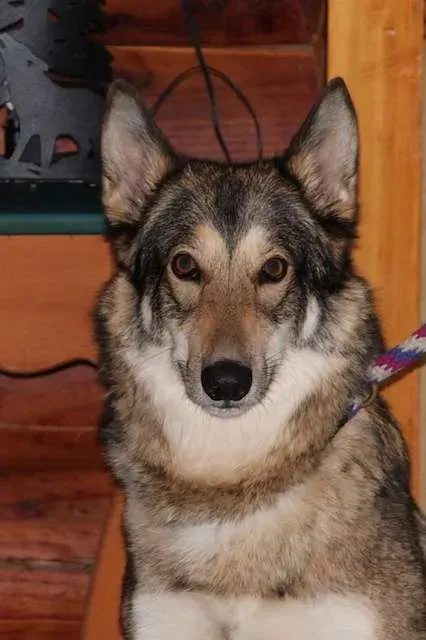Wolfdog hybrids captivate with their striking wild beauty, but they often live in fear and uncertainty, far from the domesticated world of typical dogs. Meet Bits, a stunning wolfdog—possibly mixed with coyote—who has found refuge at Grey Wolf Central Wisconsin Rescue. Rescued two years ago as a terrified bundle from a shelter, Bits now cautiously shares space with trusted humans like Jayne and Mike Belskey. His drop-dead gorgeous appearance breaks hearts, reminding us why wolfdog hybrids demand special care and why breeding them creates endless challenges for rescues and owners alike.
 Stunning wolfdog hybrid Bits relaxing cautiously in the rescue home
Stunning wolfdog hybrid Bits relaxing cautiously in the rescue home
Meeting Bits During the Annual Vet Visit
The chance to meet Bits came during Grey Wolf Rescue’s annual veterinary check-up, where the wolfdogs were already stressed by medical exams. Leashed briefly for vaccinations and blood tests to screen for tick-borne diseases, Bits glanced directly at a visitor, revealing a poignant expression that speaks volumes about his wary nature. Techniques like avoiding eye contact, yawning, and speaking softly helped him relax enough to lie down nearby, a small victory in building trust with these sensitive animals.
Wolfdog hybrids like Bits embody raw wilderness in a domestic setting. Their terror of strangers stems from instincts that clash with human homes. At the rescue, handlers prioritize calm environments to minimize stress, a key aspect of wolfdog care that typical dog owners rarely encounter.
Personal Encounters with Challenging Wolfdog Hybrids
Experiences with wolfdog hybrids highlight their unique demands. One unforgettable case involved a four-month-old, reportedly 75% wolf, living in an apartment with unprepared owners. This brilliant, energetic pup scaled furniture, chewed notebooks, peed indoors, and tore down blinds in endless cycles—energy bursting like mist from a lake. Despite interventions, her unstoppable drive overwhelmed the couple. Breeders refused returns, rescues were full, and her fate remains unknown, underscoring the flood of suffering from impulsive breeding.
 Wolfdog receiving gentle veterinary care at Grey Wolf Rescue, muzzled for safety
Wolfdog receiving gentle veterinary care at Grey Wolf Rescue, muzzled for safety
Another adolescent wolfdog, around six months old, delivered a clear message during a training mishap: possession aggression ruled. Trading a toy for chicken backfired spectacularly—he bit hard while locking eyes, communicating boundaries no domestic dog would enforce so fiercely. Weeks later, a severe bite led to euthanasia. These stories reveal wolfdog hybrids’ intelligence and independence, traits that make them poor fits for average homes without vast space and expertise.
Wolfdog care requires understanding their hybrid nature: not fully wolf, not fully dog. They crave miles of daily trotting, reject human leadership, and view equals rather than owners. Domestic life stifles them, leading to stress, escapes, or aggression.
The Ethical Dilemma of Wolfdog Hybrids
Naming them “wolfdog hybrids” perfectly captures their awkward limbo—they can’t thrive in the wild or most homes. Some succeed with dedicated owners, but breeding wolves to dogs floods rescues with misfits. Expert witness testimonies and blacklists from breeders highlight the risks: children, other pets, and owners face dangers.
Jayne Belskey, founder of Grey Wolf Rescue since 1999, shares profound insights: “I started by default with one abandoned pup… After 14 years, I understand their draw, but many face bone-crushing sadness. They don’t fit domestic or wild worlds, ending up chained or in small pens for ego boosts.” She views captive wildlife as an oxymoron—wolves belong free, not backyard-bound.
Her network aids committed owners, but demand outstrips supply: “If I built 20 enclosures, they’d fill tomorrow.” This commitment defines ethical wolfdog care, prioritizing welfare over novelty.
Life at Grey Wolf Central Wisconsin Rescue
Grey Wolf Rescue exemplifies dedication. Jayne and Mike built secure, spacious enclosures for male-female pairs, housing animals with tragic backstories—abandonments, failed adoptions, near-euthanasia. Daily care is hands-on: gentle captures, muzzling for safety, quick exams by vets like Dr. Pam Prochaska.
Not a tourist spot, the sanctuary shields stress-prone wolfdogs from visitors. Donations sustain this vital work; contributions directly support enclosures, vet care, and nutrition tailored to their high-energy needs.
 Young fawn encountered en route to the wolfdog rescue, symbolizing wild beauty
Young fawn encountered en route to the wolfdog rescue, symbolizing wild beauty
Why Avoid Breeding Wolfdog Hybrids: A Call for Responsible Pet Choices
Wolfdog hybrids’ plight urges caution against exotic breeding. Read Part Wild by Ceiridwen Terrill for a raw account of their trapped existence. Rescues like Grey Wolf strain under the volume, begging the question: Are wolfdog hybrids common in your area? Reports note surges in the Midwest and West U.S.—what about elsewhere?
Support efforts like Wisconsin’s “Ride for Wolves” against using dog packs in hunts. For pet lovers, stick to purebred or mixed domestic dogs suited to homes.
In conclusion, wolfdog hybrids dazzle but suffer from mismatched worlds. Dedicated rescues provide solace, but prevention through ethical breeding is key. Consult experts, support sanctuaries like Grey Wolf Central Wisconsin Rescue, and choose pets that thrive with you. Share your local insights—have you encountered wolfdog challenges?
References
- Belskey, J. (2013). Personal communication at Grey Wolf Central Wisconsin Rescue.
- Terrill, C. (2012). Part Wild: One Woman’s Journey with a Creature Caught Between the Worlds of Wolves and Dogs. Simon & Schuster.
- Patricia McConnell’s blog: Original experiences documented at patriciamcconnell.com (2013 entries).
- Grey Wolf Rescue: www.thegreywolf.org
 Backyard construction disrupting native plants during home improvements near the rescue
Backyard construction disrupting native plants during home improvements near the rescue
